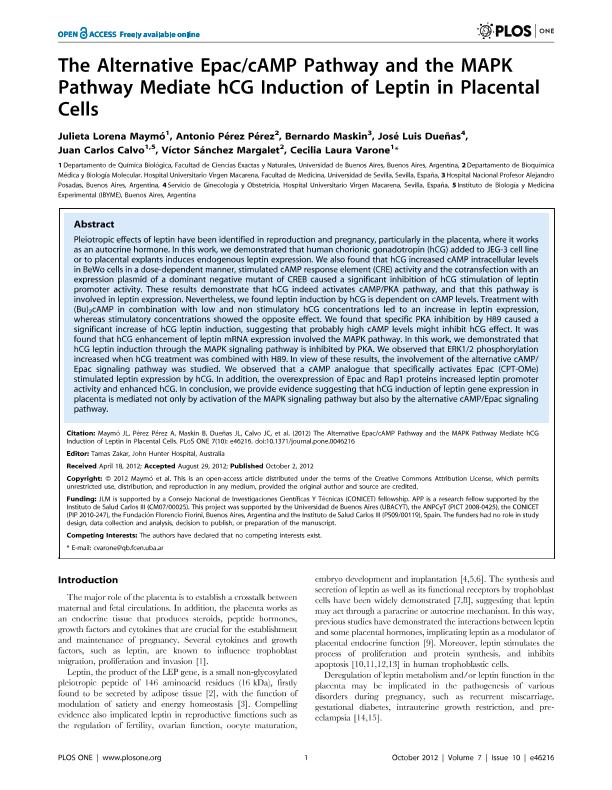Mostrar el registro sencillo del ítem
dc.contributor.author
Maymo, Julieta Lorena

dc.contributor.author
Pérez Pérez, Antonio
dc.contributor.author
Maskin, Bernardo
dc.contributor.author
Dueñas, José Luis
dc.contributor.author
Calvo, Juan Carlos

dc.contributor.author
Sánchez Margalet, Víctor
dc.contributor.author
Varone, Cecilia Laura

dc.date.available
2024-03-15T18:19:46Z
dc.date.issued
2012-10
dc.identifier.citation
Maymo, Julieta Lorena; Pérez Pérez, Antonio; Maskin, Bernardo; Dueñas, José Luis; Calvo, Juan Carlos; et al.; The Alternative Epac/cAMP Pathway and the MAPK Pathway Mediate hCG Induction of Leptin in Placental Cells; Public Library of Science; Plos One; 7; 10; 10-2012; 1-13
dc.identifier.issn
1932-6203
dc.identifier.uri
http://hdl.handle.net/11336/230714
dc.description.abstract
Pleiotropic effects of leptin have been identified in reproduction and pregnancy, particularly in the placenta, where it works as an autocrine hormone. In this work, we demonstrated that human chorionic gonadotropin (hCG) added to JEG-3 cell line or to placental explants induces endogenous leptin expression. We also found that hCG increased cAMP intracellular levels in BeWo cells in a dose-dependent manner, stimulated cAMP response element (CRE) activity and the cotransfection with an expression plasmid of a dominant negative mutant of CREB caused a significant inhibition of hCG stimulation of leptin promoter activity. These results demonstrate that hCG indeed activates cAMP/PKA pathway, and that this pathway is involved in leptin expression. Nevertheless, we found leptin induction by hCG is dependent on cAMP levels. Treatment with (Bu)2cAMP in combination with low and non stimulatory hCG concentrations led to an increase in leptin expression, whereas stimulatory concentrations showed the opposite effect. We found that specific PKA inhibition by H89 caused a significant increase of hCG leptin induction, suggesting that probably high cAMP levels might inhibit hCG effect. It was found that hCG enhancement of leptin mRNA expression involved the MAPK pathway. In this work, we demonstrated that hCG leptin induction through the MAPK signaling pathway is inhibited by PKA. We observed that ERK1/2 phosphorylation increased when hCG treatment was combined with H89. In view of these results, the involvement of the alternative cAMP/ Epac signaling pathway was studied. We observed that a cAMP analogue that specifically activates Epac (CPT-OMe) stimulated leptin expression by hCG. In addition, the overexpression of Epac and Rap1 proteins increased leptin promoter activity and enhanced hCG. In conclusion, we provide evidence suggesting that hCG induction of leptin gene expression in placenta is mediated not only by activation of the MAPK signaling pathway but also by the alternative cAMP/Epac signaling pathway.
dc.format
application/pdf
dc.language.iso
eng
dc.publisher
Public Library of Science

dc.rights
info:eu-repo/semantics/openAccess
dc.rights.uri
https://creativecommons.org/licenses/by/2.5/ar/
dc.subject
LEPTIN
dc.subject
HCG
dc.subject
CAMP
dc.subject
PLACENTA
dc.subject
GENE EXPRESSION
dc.subject
PKA
dc.subject
MAPK SIGNAL TRANSDUCTION PATHWAY
dc.subject
EPAC/CAMP ALTERNATIVE PATHWAY
dc.subject.classification
Bioquímica y Biología Molecular

dc.subject.classification
Medicina Básica

dc.subject.classification
CIENCIAS MÉDICAS Y DE LA SALUD

dc.title
The Alternative Epac/cAMP Pathway and the MAPK Pathway Mediate hCG Induction of Leptin in Placental Cells
dc.type
info:eu-repo/semantics/article
dc.type
info:ar-repo/semantics/artículo
dc.type
info:eu-repo/semantics/publishedVersion
dc.date.updated
2024-02-22T13:40:02Z
dc.journal.volume
7
dc.journal.number
10
dc.journal.pagination
1-13
dc.journal.pais
Estados Unidos

dc.journal.ciudad
San Francisco
dc.description.fil
Fil: Maymo, Julieta Lorena. Universidad de Buenos Aires. Facultad de Ciencias Exactas y Naturales. Departamento de Química Biológica; Argentina. Consejo Nacional de Investigaciones Científicas y Técnicas. Oficina de Coordinación Administrativa Ciudad Universitaria; Argentina
dc.description.fil
Fil: Pérez Pérez, Antonio. Universidad de Sevilla; España
dc.description.fil
Fil: Maskin, Bernardo. Hospital Nacional Profesor Alejandro Posadas; Argentina
dc.description.fil
Fil: Dueñas, José Luis. Hospital Universitario Virgen Macarena; España
dc.description.fil
Fil: Calvo, Juan Carlos. Universidad de Buenos Aires. Facultad de Ciencias Exactas y Naturales. Departamento de Química Biológica; Argentina. Consejo Nacional de Investigaciones Científicas y Técnicas. Instituto de Biología y Medicina Experimental. Fundación de Instituto de Biología y Medicina Experimental. Instituto de Biología y Medicina Experimental; Argentina
dc.description.fil
Fil: Sánchez Margalet, Víctor. Universidad de Sevilla; España
dc.description.fil
Fil: Varone, Cecilia Laura. Universidad de Buenos Aires. Facultad de Ciencias Exactas y Naturales. Departamento de Química Biológica; Argentina. Consejo Nacional de Investigaciones Científicas y Técnicas. Oficina de Coordinación Administrativa Ciudad Universitaria. Instituto de Química Biológica de la Facultad de Ciencias Exactas y Naturales. Universidad de Buenos Aires. Facultad de Ciencias Exactas y Naturales. Instituto de Química Biológica de la Facultad de Ciencias Exactas y Naturales; Argentina
dc.journal.title
Plos One

dc.relation.alternativeid
info:eu-repo/semantics/altIdentifier/url/http://www.plosone.org/article/info%3Adoi%2F10.1371%2Fjournal.pone.0046216
dc.relation.alternativeid
info:eu-repo/semantics/altIdentifier/doi/http://dx.doi.org/10.1371/journal.pone.0046216
Archivos asociados
